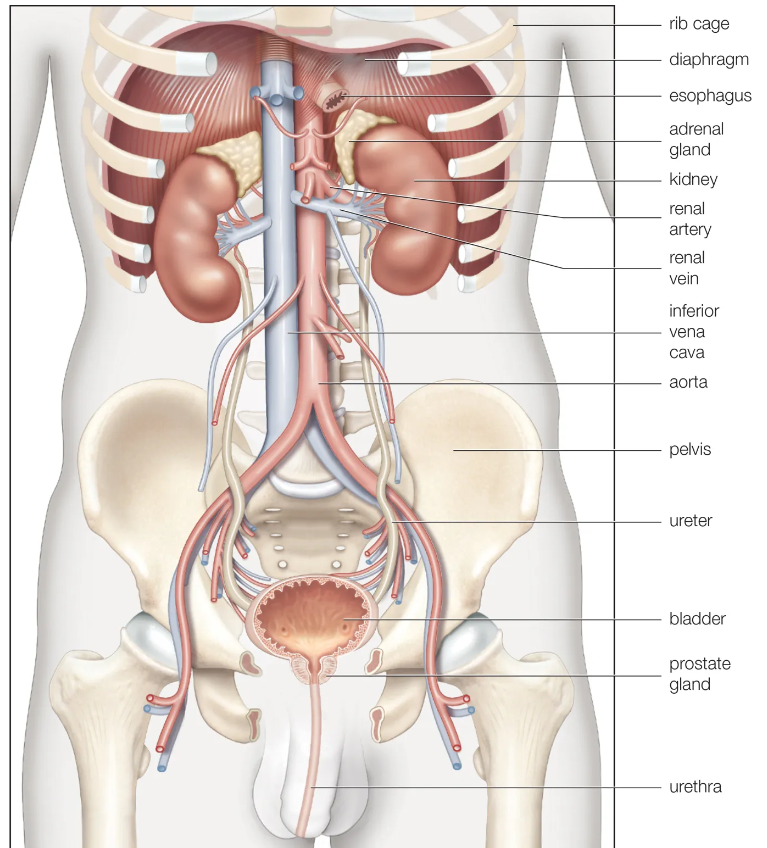Calyceal cysts are fluid-filled sacs that form in the kidney’s calyx, which is part of the kidney’s collecting system. These cysts are generally benign (non-cancerous) and often do not cause symptoms. Understanding calyceal cysts involves exploring their structure, potential causes, symptoms, diagnostic methods, treatments, and prevention.
Pathophysiology
Structure
The kidney has several parts, including:
- Calyces: Small cup-like structures that collect urine from the kidney.
- Renal Pelvis: The area where urine collects before it moves to the bladder.
Calyceal cysts occur in these calyx areas. They can vary in size and number.
Blood Supply
The kidneys receive blood from the renal arteries, which branch off from the abdominal aorta. This blood is crucial for kidney function, as it helps filter waste and regulate blood pressure.
Nerve Supply
The kidney is innervated by the autonomic nervous system, which controls involuntary functions. This includes blood flow regulation and the release of hormones that manage kidney function.

Types of Calyceal Cysts
- Simple Cysts: Typically small, fluid-filled sacs that are not harmful.
- Complex Cysts: May contain solid components or septations and can require further evaluation.
- Multicystic Dysplastic Kidney: A condition where the kidney develops multiple cysts, affecting its function.
- Acquired Cysts: Develop in response to conditions such as kidney disease.
Causes of Calyceal Cysts
- Genetic predisposition
- Age-related changes
- Kidney diseases (e.g., polycystic kidney disease)
- Blockages in the urinary tract
- Infections
- Trauma to the kidney
- Congenital abnormalities
- Kidney stones
- High blood pressure
- Diabetes
- Previous kidney surgery
- Inherited syndromes (e.g., von Hippel-Lindau disease)
- Hormonal changes
- Environmental factors (toxins)
- Obesity
- Smoking
- Chronic kidney conditions
- Vascular diseases
- Cysts in other organs
- Systemic diseases (e.g., lupus)
Symptoms of Calyceal Cysts
Calyceal cysts often do not cause symptoms. However, when they do, symptoms may include:
- Abdominal pain
- Flank pain (side pain)
- Nausea
- Vomiting
- Hematuria (blood in urine)
- Frequent urination
- Urinary urgency
- Back pain
- Fever (if infection is present)
- Weight loss (unexplained)
- Fatigue
- Changes in urine color
- Difficulty urinating
- Swelling in legs or ankles
- Increased blood pressure
- Pain during urination
- Kidney infection symptoms
- Side effects from other kidney conditions
- Cyst growth (observable on imaging)
- General malaise
Diagnostic Tests for Calyceal Cysts
Diagnosing calyceal cysts typically involves several tests, including:
- Ultrasound: Uses sound waves to create images of the kidneys.
- CT Scan: Provides detailed cross-sectional images.
- MRI: Uses magnetic fields to visualize soft tissues.
- X-ray: Can show kidney stones or cysts.
- Urinalysis: Tests urine for blood, infection, or other abnormalities.
- Blood Tests: Check kidney function and overall health.
- Renal Angiography: Visualizes blood vessels in the kidneys.
- Biopsy: Rarely needed, but can confirm cyst characteristics.
- Nuclear Scintigraphy: Assesses kidney function.
- Cystoscopy: A scope is inserted into the bladder to view the ureters.
- IV Pyelogram: An X-ray test using a contrast dye.
- Urine Culture: Tests for infections.
- 24-Hour Urine Collection: Assesses kidney function over a full day.
- Blood Urea Nitrogen (BUN) Test: Measures waste in the blood.
- Creatinine Test: Assesses kidney function.
- Electrolyte Panel: Checks balance of minerals in the blood.
- Complete Blood Count (CBC): Assesses overall health.
- Genetic Testing: If genetic conditions are suspected.
- Liver Function Tests: To rule out systemic issues.
- Cyst Fluid Analysis: If a cyst is aspirated.
Non-Pharmacological Treatments
Many cases of calyceal cysts do not require medication. Non-pharmacological treatments include:
- Regular monitoring: Follow-ups with imaging.
- Hydration: Drinking plenty of fluids.
- Dietary changes: Reducing sodium and unhealthy fats.
- Weight management: Maintaining a healthy weight.
- Exercise: Regular physical activity to improve overall health.
- Stress management: Techniques such as yoga or meditation.
- Avoiding caffeine: Reducing caffeine intake may help.
- Smoking cessation: Quitting smoking to improve health.
- Limit alcohol: Reducing or eliminating alcohol consumption.
- Healthy eating: Focusing on a balanced diet.
- Regular health check-ups: Monitoring kidney health.
- Avoiding NSAIDs: Reducing non-steroidal anti-inflammatory drugs.
- Managing underlying conditions: Such as hypertension or diabetes.
- Herbal remedies: Some may support kidney health (consult with a doctor).
- Physical therapy: If experiencing pain.
- Acupuncture: May relieve some symptoms.
- Homeopathy: Alternative treatment options.
- Support groups: Connecting with others for emotional support.
- Education: Learning about kidney health.
- Mindfulness: Techniques to reduce anxiety.
Medications for Calyceal Cysts
If treatment is necessary, certain medications may be used:
- Pain relievers: For discomfort (e.g., acetaminophen).
- Antibiotics: If an infection is present.
- Blood pressure medications: To manage hypertension.
- Diuretics: To help with fluid retention.
- Hormonal medications: If cysts are related to hormonal issues.
- Anti-inflammatory drugs: To reduce inflammation.
- Corticosteroids: In some cases of severe inflammation.
- Antispasmodics: For muscle spasms in the urinary tract.
- Vitamins and supplements: To support overall kidney health.
- Medication for diabetes: If applicable.
- Cholesterol-lowering drugs: To manage lipid levels.
- Medications for other underlying conditions: As required.
- Supportive care medications: For related symptoms.
- Analgesics: For managing pain.
- Nutritional supplements: If dietary intake is insufficient.
- Antidepressants: If stress or anxiety is a concern.
- Medication for urinary tract issues: If applicable.
- Medication to manage side effects: Of other treatments.
- Topical medications: If there are skin-related issues.
- Experimental drugs: In clinical trials for renal conditions.
Surgical Options for Calyceal Cysts
In some cases, surgery may be necessary. Surgical options include:
- Cyst aspiration: Removing fluid from the cyst.
- Cyst excision: Surgically removing the cyst.
- Laparoscopic surgery: Minimally invasive approach to cyst removal.
- Open surgery: Traditional method for larger cysts.
- Nephrectomy: Removal of part or all of the kidney if severely affected.
- Endoscopic procedures: Using a camera to treat cysts.
- Cryoablation: Freezing the cyst to reduce its size.
- Radiofrequency ablation: Using heat to shrink the cyst.
- Drainage procedures: To relieve symptoms.
- Bilateral nephrectomy: Rarely, removal of both kidneys in severe cases.
Prevention of Calyceal Cysts
While not all cysts are preventable, some measures can reduce the risk:
- Healthy diet: Eating nutritious foods.
- Hydration: Drinking plenty of water.
- Regular exercise: To maintain overall health.
- Weight management: Avoiding obesity.
- Avoiding smoking: To protect kidney health.
- Limiting alcohol: Reducing intake.
- Managing blood pressure: Keeping it within a healthy range.
- Controlling diabetes: Keeping blood sugar levels stable.
- Routine check-ups: Monitoring kidney health.
- Prompt treatment of urinary infections: To prevent complications.
When to See a Doctor
You should see a doctor if you experience:
- Persistent flank pain.
- Blood in urine.
- Severe abdominal pain.
- Symptoms of a urinary tract infection (UTI).
- Unexplained weight loss.
- Fever or chills.
- Nausea or vomiting that doesn’t go away.
- Difficulty urinating.
- Swelling in the legs or ankles.
- Sudden changes in urine color or smell.
FAQs about Calyceal Cysts
- What are calyceal cysts?
- Fluid-filled sacs in the kidney’s calyx.
- Are calyceal cysts dangerous?
- Most are benign and not harmful.
- How are calyceal cysts diagnosed?
- Through imaging tests like ultrasound and CT scans.
- What causes calyceal cysts?
- Various factors, including genetics and kidney disease.
- Do calyceal cysts require treatment?
- Not usually, but symptoms may need management.
- What symptoms do they cause?
- Often asymptomatic, but may cause pain or urinary issues.
- Can calyceal cysts become cancerous?
- Rarely; most are non-cancerous.
- How are they treated?
- Treatments include monitoring, medications, and sometimes surgery.
- Can lifestyle changes help?
- Yes, a healthy lifestyle can improve kidney health.
- When should I see a doctor?
- If you experience severe symptoms or changes in kidney function.
- Are there any long-term effects?
- Generally, no, but monitoring is important.
- Can I prevent calyceal cysts?
- Some lifestyle choices may reduce risk.
- Is surgery always necessary?
- No, many cysts do not require surgery.
- How often should I have check-ups?
- Follow your doctor’s advice based on your health status.
- What is the prognosis for calyceal cysts?
- Most people do well with appropriate monitoring and care.
Conclusion
Calyceal cysts are common and often harmless. Understanding their causes, symptoms, and treatment options can help you manage your kidney health effectively. If you have concerns or experience symptoms, consult a healthcare provider for personalized advice.
Disclaimer: Each person’s journey is unique, treatment plan, life style, food habit, hormonal condition, immune system, chronic disease condition, geological location, weather and previous medical history is also unique. So always seek the best advice from a qualified medical professional or health care provider before trying any treatments to ensure to find out the best plan for you. This guide is for general information and educational purposes only. Regular check-ups and awareness can help to manage and prevent complications associated with these diseases conditions. If you or someone are suffering from this disease condition bookmark this website or share with someone who might find it useful! Boost your knowledge and stay ahead in your health journey. We always try to ensure that the content is regularly updated to reflect the latest medical research and treatment options. Thank you for giving your valuable time to read the article.


















